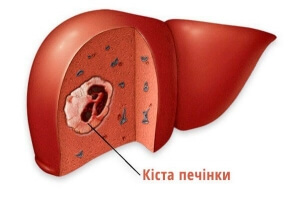The hepatic cyst can progress, but be «silent» for years: symptoms appear in the late stages. In which cases the cyst needs to be operated on, and when - the operation can be postponed, advises the surgeon of the Bogoliuby Center » Oleksandr Masikov.
Why do cysts form in the liver?
A liver cyst is a cavity in the thickness of an organ filled with liquid contents. It is most often found in women aged 30 to 50 years. Neoplasms are diagnosed both on the surface of the liver and inside it, that is, it does not have a specific characteristic location and can form absolutely anywhere in the organ.
By origin, cysts are congenital and acquired. The most common cause of acquired cysts is trauma and inflammatory liver disease. In a separate group, parasitic cysts are identified, caused by infection with flatworms - echinococcus or alveococcus.
How can a person become infected with parasitic cyst pathogens?
Parasitic cysts develop after direct contact with animals and do not have symptoms of the disease. In turn, they are usually divided into echinococcal and alveococcal.
Echinococcus is most often transmitted from dogs and wolves, alveococcus - from cats, foxes, rodents. Infection occurs by the ingestion of helminth eggs in the human body through unwashed hands, dirty water and unprocessed food.
What are the symptoms of liver cysts?
The cyst manifests itself in different ways, depending on the type, place of formation, magnitude and type of complication. Small and non-parasitic cysts often do not have clinical manifestations and are detected by chance during an ultrasound scan or computer-aided tomography of the abdominal cavity. Such cysts do not require treatment, only observation.
Cysts larger than 8 cm can accompany pain, nausea, bloating, as well as jaundice and ascites when the cyst compresses the bile ducts and blood vessels. Terrible complications are suppuration, rupture of the cyst, bleeding.
How can a cyst be diagnosed?
The most affordable diagnostic - method is ultrasound of the abdominal cavity and retroperitoneal space. More detailed information is provided by computer-aided tomography. With its help, it is possible to accurately determine the size and location of the cyst, and plan the course of treatment. When there is suspicion of the parasitic origin of the cyst, a blood test is necessary.
How are liver cysts treated?
Depending on the location and clinical course, several treatment methods are used, namely:
- Percutaneous cyst puncture under ultrasound control. For the treatment of echinococcal cysts, it has been successfully used in the so-called PAIR modification.
- Disclosure and partial removal of the cyst. This technique is used for superficially located cysts that protrude above the surface of the organ and are covered with only a thin layer of tissue, and can be performed with either classic or laparoscopic access. To prevent relapse, the residual cavity of the cyst can be covered with a flap of the greater omentum - its own adipose tissue, or with special medications containing fibrin or cellulose.
- Removal of an echinococcal cyst has a number of features due to the danger of contamination of the internal organs and the formation of new cysts. Resection of the liver, that is, the removal of one or more segments, or even an entire lobe. Such volumetric and complex interventions are resorted to with large complicated bones, as well as with parasitic lesions of alveococcus.
In Bogoliuby MC are used the most progressive method - laparoscopic removal of liver cysts. This technique eliminates large incisions (which means also postoperative scars), but manipulations in the abdominal cavity are performed with instruments up to 10 mm in diameter. Such access prevents the formation of adhesions between the organs of the abdominal cavity, minimizes the period of postoperative rehabilitation. Stay in hospital is reduced to 2-3 days.
What are the subtleties of treating parasitic liver cysts?
In the treatment of parasitic cysts, the patient simultaneously receives anthelmintic drugs mebendazole or albendazole for a month. An alternative method of treating parasitic cysts in the absence of contraindications is prolonged chemotherapy, when the patient receives anthelmintic drugs for a year. However, complete recovery without surgery occurs in no more than 30% of patients.
How to prepare for surgery?
In the period before and after the operation, you need to follow a diet to cleanse the liver and prepare for subsequent recovery. The diet prohibits fatty, fried, salted, smoked and canned foods, as well as coffee, sauces, spices, seasonings, sweet and carbonated drinks.
. What are the prognoses for a patient with a liver cyst?
In most cases, after removing cyst surgery, the prognosis is positive. Complications and relapses are rarely, but they are treated. If you have a liver cyst, you should consult a doctor, determine its nature and make a diagnosis. And even if during the initial diagnosis they say that they are non-parasitic cysts and nothing needs to be done, it is better to go through the full list of necessary examinations to make sure the diagnosis.
If abnormalities or negative effects are noticed during dynamic observation, you should not wait and look for how to treat a cyst on the liver, but agree to an operation. If cysts are not timely detected and are not treated by appropriate methods, they can cause stagnation of bile, pancreatitis, ascites, and varicose veins of the digestive tract. In addition, there is a risk of a malignant tumor at the site of the cyst.

















